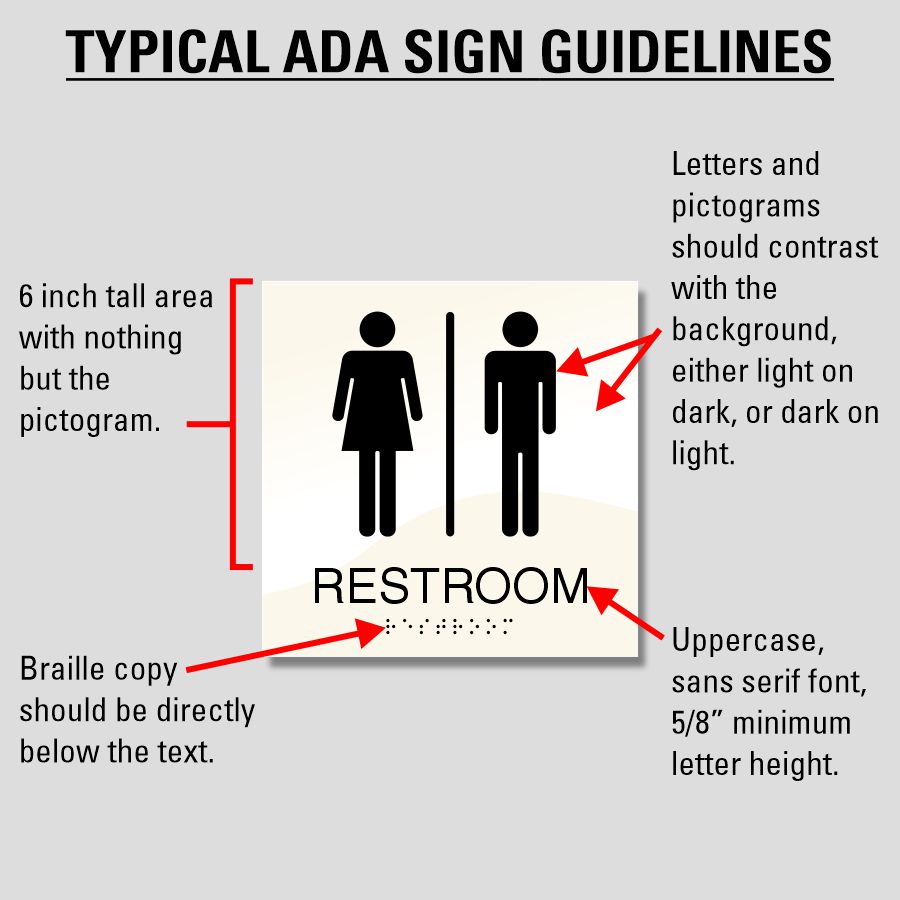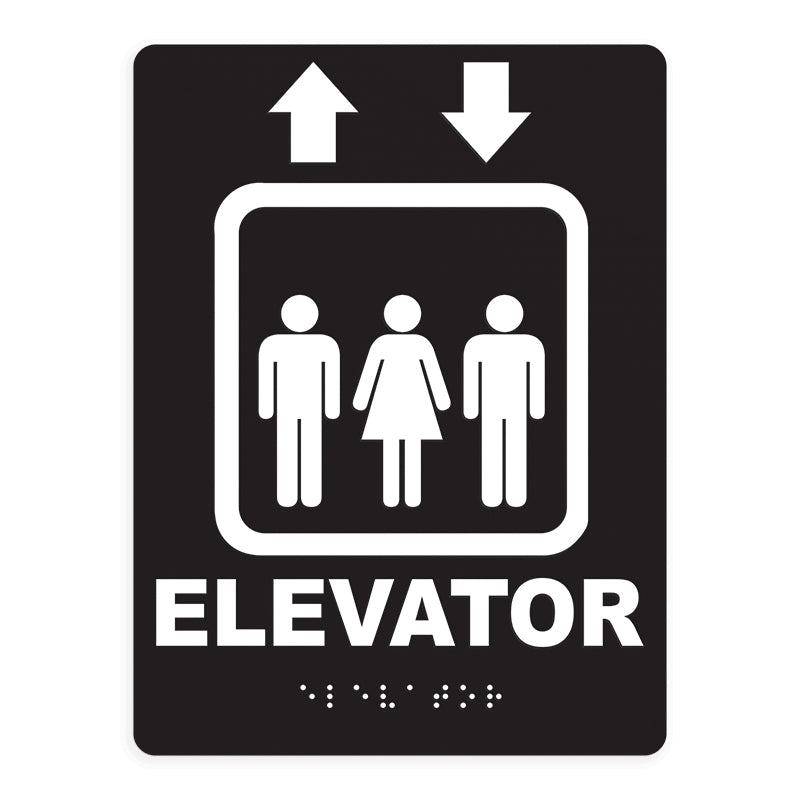Check out the Value of ADA Signs in Public Spaces
Checking Out the Secret Functions of ADA Indications for Improved Ease Of Access
In the world of availability, ADA indicators act as quiet yet effective allies, making sure that areas are navigable and inclusive for people with impairments. By integrating Braille and tactile aspects, these signs break barriers for the aesthetically damaged, while high-contrast color systems and legible font styles accommodate varied visual demands. Their tactical positioning is not arbitrary however rather a computed initiative to facilitate smooth navigation. Yet, past these functions exists a deeper story concerning the advancement of inclusivity and the continuous commitment to producing fair rooms. What a lot more could these indications symbolize in our quest of global accessibility?
Significance of ADA Conformity
Guaranteeing conformity with the Americans with Disabilities Act (ADA) is vital for promoting inclusivity and equal accessibility in public rooms and workplaces. The ADA, passed in 1990, mandates that all public centers, companies, and transport solutions accommodate individuals with disabilities, ensuring they take pleasure in the exact same civil liberties and opportunities as others. Conformity with ADA standards not only satisfies lawful obligations however likewise boosts an organization's track record by showing its dedication to diversity and inclusivity.
One of the essential elements of ADA conformity is the application of obtainable signage. ADA indicators are designed to make certain that people with impairments can easily navigate via rooms and structures.
Moreover, adhering to ADA guidelines can mitigate the risk of possible fines and legal repercussions. Organizations that fail to adhere to ADA standards may encounter suits or fines, which can be both monetarily troublesome and destructive to their public photo. Hence, ADA conformity is important to cultivating an equitable atmosphere for everybody.
Braille and Tactile Aspects
The consolidation of Braille and tactile components right into ADA signs symbolizes the principles of access and inclusivity. These attributes are essential for people that are aesthetically damaged or blind, allowing them to browse public rooms with higher self-reliance and confidence. Braille, a responsive writing system, is necessary in giving composed details in a layout that can be conveniently perceived with touch. It is commonly placed below the corresponding message on signs to make sure that individuals can access the details without visual support.
Tactile aspects prolong beyond Braille and include raised signs and characters. These elements are created to be noticeable by touch, allowing individuals to determine space numbers, restrooms, leaves, and various other critical areas. The ADA sets certain guidelines pertaining to the dimension, spacing, and positioning of these responsive aspects to maximize readability and make sure uniformity across different atmospheres.
High-Contrast Color Pattern
High-contrast color design play a crucial duty in boosting the exposure and readability of ADA signs for individuals with visual problems. These systems are necessary as they optimize the distinction in light reflectance in Discover More between message and history, making sure that indications are easily discernible, also from a range. The Americans with Disabilities Act (ADA) mandates the usage of certain color contrasts to suit those with minimal vision, making it a critical facet of conformity.
The effectiveness of high-contrast shades depends on their capability to stand out in different lighting problems, consisting of poorly lit settings and areas with glow. Generally, dark message on a light history or light message on a dark background is used to achieve optimum contrast. Black message on a white or yellow history offers a raw aesthetic difference that helps in fast acknowledgment and understanding.

Legible Fonts and Text Size
When taking into consideration the design of ADA signage, the option of readable typefaces and ideal message size can not be overstated. These aspects are crucial for making sure that indicators are available to people with aesthetic problems. The Americans with Disabilities Act (ADA) mandates that typefaces have to be sans-serif and not italic, oblique, manuscript, very attractive, or of uncommon kind. These needs aid ensure that the text is easily readable from a distance and that the characters are appreciable to varied audiences.
According to ADA guidelines, the minimum message elevation ought to be 5/8 inch, and it needs to boost proportionally with seeing range. Consistency in text dimension contributes to a natural visual experience, assisting individuals in navigating atmospheres you can look here efficiently.
Furthermore, spacing between letters and lines is essential to legibility. Ample spacing stops characters from showing up crowded, enhancing readability. By adhering to these requirements, designers can dramatically enhance accessibility, making sure that signs serves its desired purpose for all people, no matter their visual capabilities.
Effective Positioning Approaches
Strategic positioning of ADA signs is crucial for maximizing access and ensuring conformity with lawful requirements. ADA guidelines state that indications need to be mounted at a height in between 48 to 60 inches from the ground to ensure they are within the line of sight for both standing and seated people.
In addition, indications should be positioned nearby to the latch side of doors to permit simple recognition prior to entry. Uniformity in sign positioning throughout a facility enhances predictability, minimizing confusion and boosting overall user experience.

Verdict
ADA signs play a crucial role in promoting accessibility by integrating features that attend to the needs of individuals with disabilities. Integrating Braille and responsive components guarantees essential information comes to the visually damaged, while high-contrast color design and clear sans-serif font styles boost visibility across different illumination problems. Reliable placement approaches, such as appropriate placing heights and strategic places, even more assist in navigating. These components collectively foster an inclusive atmosphere, highlighting the value of ADA conformity in making certain equivalent accessibility for all.
In the realm of accessibility, ADA signs offer as quiet yet effective allies, making sure that areas are inclusive and navigable for individuals with disabilities. The ADA, enacted in 1990, mandates that all public facilities, companies, and transport solutions fit individuals with impairments, ensuring they enjoy the same civil liberties and possibilities as others. ADA Signs. ADA indicators are made to ensure that people with handicaps can quickly navigate through areas and structures. ADA guidelines specify that indicators ought to be mounted at an elevation between 48 to 60 article source inches from the ground to ensure they are within the line of view for both standing and seated individuals.ADA signs play an essential role in promoting access by integrating features that attend to the needs of people with impairments